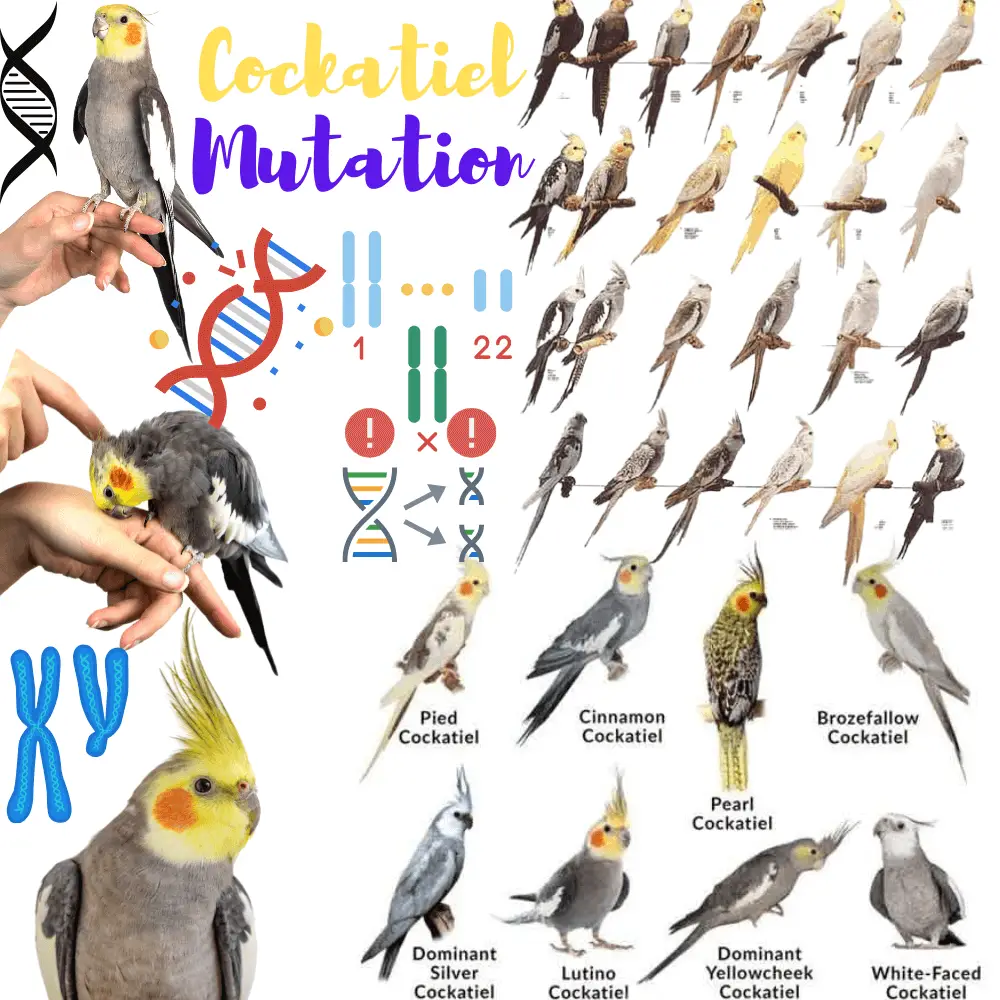
Cockatiel Mutation: There are many different colors and mutations of cockatiels to choose from when buying cockatiels It is important to remember that regardless of the color or mutation variation of cockatiels, each of them is of the same species and has the same health and care needs over time. Thus, you don’t need to learn anything special about the particular color you are looking for.
Just make sure you understand how to properly care for cockatiels in general. Which cockatiels color or mutation do you prefer? We want to hear from you in our comments section below.
The wild color of the cockatiel parakeet is at the gray base. The gradual arrival and mass reproduction of cocktails in our European farms have undeniably led breeders to obtain subjects whose colors gradually deviated from the natural color.
This is how the various mutations that we are currently experiencing were born. All these mutations can be “controlled” with a minimum of genetic knowledge.
Indeed, although complex for any neophyte, it can prove to be child’s play when a few basic rules that are easy to understand are applied. The following is training material developed by Thierry Duliere. I thank him very much for his authorization to publish it.
It is usually used to help amateur breeders understand the basics of genetics. The method used is unconventional but allows everyone to easily understand and become independent about the constitution of their matings.
Of course, their publication is simply subject to prior authorization from the author Thierry Dulière.
Cockatiel Genetics
Genetics is full of complex and difficult-to-understand terms. In order to help everyone understand the subject, a familiarization of genetic language is necessary.
Some words may seem new and their meaning may not be clear in your mind.
Mutation, Gene, Chromosome, Phenotype…A whole language that you will get to know and use that will help you understand the future.
Have no fear, there is very little to learn, just a few rules to understand…
Genetics is easy to assimilate when it is explained as simple operations of calculation and logic.
Cockatiel Mutation
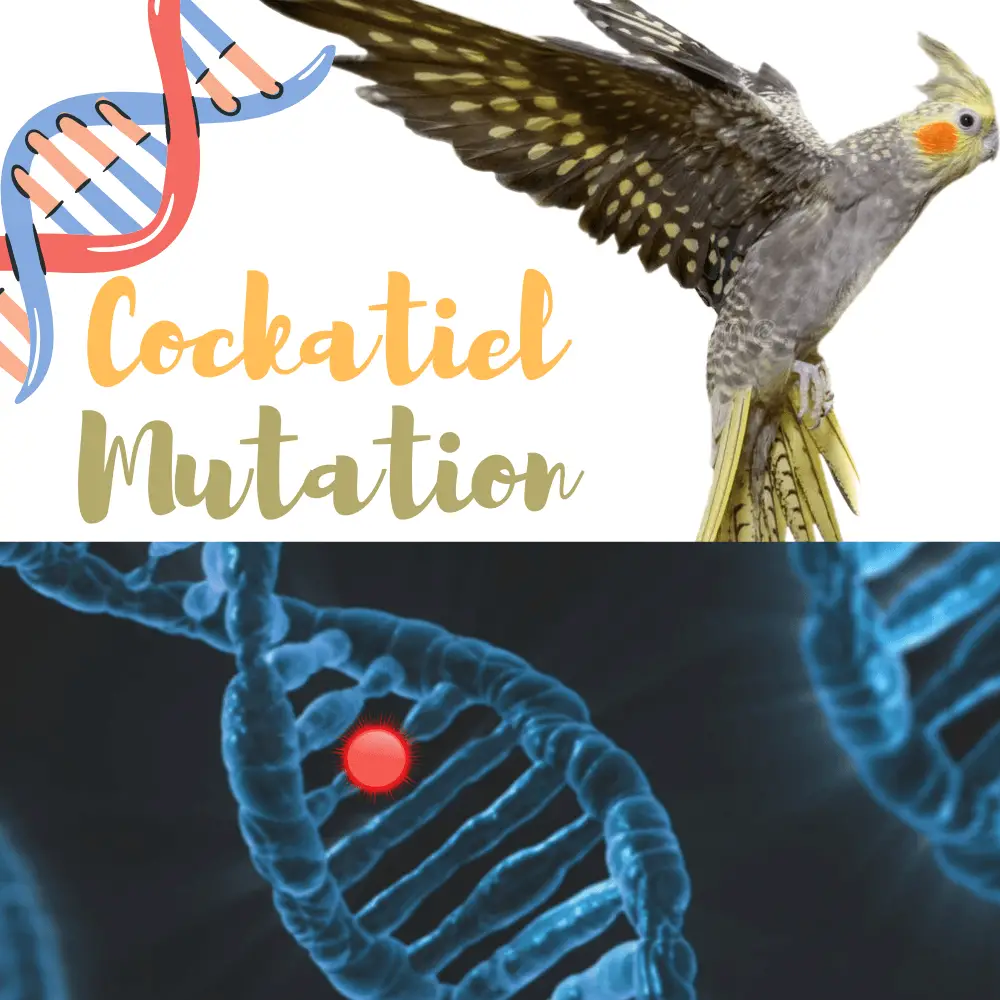
What is a cockatiel mutation?
Compared to the wild type of living beings (animals or plants), there are variations in humans: eye color, hair color, and hair texture.
In birds, you experience changes in the color, and texture of feathers (hoopoe, curl).
These changes are called mutations when they are transmissible.
Otherwise, they are mere aberrations (changes in the appearance of the bird that are not transmissible).
To understand color mutations, it is good to remember some rules learned in painting.
Reminders:
When you mix YELLOW
paint with BLUE paint, you get GREEN paint. So in painting:
GREEN=YELLOW+BLUE
- If a mutation removes the YELLOW in a GREEN bird, it is the BLUE mutation
- If a mutation removes BLUE in a GREEN bird, it is the YELLOW
mutation - If we combine the two mutations, the BLUE which removes the YELLOW and the YELLOW which removes the BLUE, we obtain a WHITE
bird
So in genetics:
|
YELLOW = GREEN – BLUE
|
WHITE is not a mutation but a combination of two mutations.
Cockatiel colors
The origin of colors:There are two main families of color origin:
- pigment colors
- Structural colors
Pigment colors
- Yellow and red psittacins (carotenoids in non-psittacidae)
- Melanins
Eumelanin
- Black if oxidized
- Brown if not oxidized
Brown phaeomelanin
Structural colors
The feather structure acts on the appearance of melanic colors
- Blue obtained by distortion of light
- The gray is obtained by modifying the spongy area of the feathers which modifies the distortion of the light
- The dark factor controls the depth of the spongy area and changes the wavelength of the light distortion (and by effect refraction).
- The violet factor alters the spongy area and results in an alteration of the wavelength of the light distortion (and by effect refraction).
These different phenomena combine to allow a multitude of colors.
Transmission of mutations
The body of birds, like living things, is composed of several million cells. Each cell contains a nucleus that contains chromosomes.
There are always two identical chromosomes per cell (= pair of chromosomes).
On each chromosome are genes. These numerous genes are also in pairs. These genes contain information such as plumage color.
Mutations are determined by genes that are attached to chromosomes at locations called locus (plural loci).
As the chromosomes that are found in each of the cells of living beings are systematically in pairs, during reproduction that will be studied in a future chapter, we will see that the young inherit half of the genetic heritage of the father and half of the genetic heritage of the mother.
The visual outward appearance of a bird is called a phenotype.
Its genetic heritage (the set of visible and hidden but transmissible traits) is called genotype.
The mode of transmission of mutations is called heredity.
Basic principles of heredity
Now we will observe the mechanism of reproduction and sex determination in young birds.
Next, we will study the two major families of heredity, namely
- sex-related inheritance and
- free heredity
but also the different types of dominance:
- recessive
- dominant
Male, Female, and Young
In birds, the male is genetically differentiated from the female by a pair of XX sex chromosomes while the sex chromosome pair of the female is XY.
!!! Careful!!! : It is XX for the male and XY for the female UNLIKE humans (XY for the man and XX for the woman.)
During normal cell multiplication (see fig. 1), the cells divide identically, a cell giving two identical cells each with the same pairs of chromosomes which in turn each give a pair of identical cells, etc.
During reproduction, in both males and females, cells divide into half-cells, each comprising half a pair of chromosomes.
So if the half-cells, which are actually the reproductive cells, from the male each have an X chromosome, those from the female have half an X chromosome, and the other half a Y.
The Y chromosome is tiny and contains almost no information.
These cells will then meet during mating and thus, from fertilization, the sex of the young will be determined.
To illustrate the different scenarios, let’s use a simple table in which we will only note the chromosomes that concern us for sex determination.
In this table, we report in the top boxes each of the chromosomes of the male and in the boxes on the left those of the female.
Then, it is enough to reconstitute, in the four boxes at the intersections of columns and rows, the pairs of chromosomes of the young
|
Male
|
|||
|
X
|
X
|
||
|
Female
|
X
|
||
|
Y
|
|||
|
Male
|
|||
|
X
|
X
|
||
|
Female
|
X
|
X X
|
X X
|
|
Y
|
XY
|
XY
|
|
You note that we have in theory:
- 2 out of 4 young who are males (50%) and
- 2 out of 4 young who are females (50%).
Sex-related recessive mutations
The locus (= location on the gene) of some mutations is located on the X chromosomes.
As a result, since it is chromosomes that determine sex, we will say that these mutations are related to sex.
These are the following mutations:
- Lutino (known as ino)
- Beaded
- Cinnamon (cinnamon or isabelle)
- Yellow cheek
Note: Note that in cockatil, there is an ino mutation not related to sex
We will take as an example the lutino mutation (=ino) related to sex.
We will simply note INO to represent the ino gene on the X chromosome and X INO to represent the non-ino gene.
Under these conditions, a male bird that has two X chromosomes with the non-ino gene will be noted: X INO X INO . This bird will be wild in color because it is not affected by the mutation.
A male bird that has two X chromosomes with the ino gene will be noted: X INO X INO. This bird will be ino-colored as it is affected by the mutation.
A male bird that has an X chromosome with the ino gene and an X chromosome with the non-ino gene will be noted: X INO X INO. This bird will be wild in color but carrying the mutation because the mutation is related to sex.
And as far as females are concerned, only two solutions can present themselves:
- a female bird that has its X chromosome with the non-ino gene will be noted: X
INO Y. This bird will be wild in color because it is not affected by the mutation. - Afemale bird that has its X chromosome with the ino gene will be noted: X INO Y. This bird will be ino-colored as it is affected by the mutation.
|
Females can never carry a sex-related mutation |
Let’s couple our different combinations in tabular form to see what the chicks give us:
Couple 1: Non-lutino male and non-lutino female
|
No ino X No ino |
Male
|
||
|
X
|
X
|
||
|
Female
|
X
|
X INO
|
X INO |
|
Y
|
X
|
X
|
|
Youth Outcomes:
50% non-ino males
50% non-ino females
Couple 2: Non-lutino male and lutino female
|
No ino x Ino |
Male
|
||
|
X
|
X
|
||
|
Female
|
XINO
|
X INO X
|
X INO X |
|
Y
|
X
|
X
|
|
Youth Outcomes:
50% of ino-carrier males
50% non-ino females
Couple 3: Lutino male and non-lutino female
|
Ino x non-ino |
Male
|
||
|
XINO
|
XINO
|
||
|
Female
|
X
|
X INO X
|
X INO X |
|
Y
|
XINOY
|
XINOY
|
|
Youth Outcomes:
50% of ino-carrier males
50% ino females
Couple 4: Lutino male and Lutino female
|
Ino x Ino |
Male
|
||
|
XINO
|
XINO
|
||
|
Fsole
|
XINO
|
X INO XINO
|
X INO XINO |
|
Y
|
XINOY
|
XINOY
|
|
Youth outcomes
50% ino males
50% ino females
Couple 5: Male carrier lutino and female non-lutino
|
Carrier ino x No ino |
Male
|
||
|
X
|
XINO
|
||
|
Female
|
X
|
X INO
|
X INO X |
|
Y
|
X
|
XINOY
|
|
Youth outcomes
25% of ino-carrier males
25% non-ino males
25% grey females
25% lutino females
Free recessive mutations
The locus of other mutations is located on chromosomes other than X sex chromosomes.
Consequently, as it is not the chromosomes that determine the sex, we will say that these mutations are free since their heredity will therefore be not dependent on the sex of the parents.
These are a large number of mutations:
-
-
White cheeks
-
Follow
-
Variegated (variegated)
-
Pastel
-
Recessive silver
-
As these mutations are independent of the sex of the parents, we will not represent the chromosomes to which they are attached.
Thus, the table will be simplified and the results will be identical by reversing male and female.
We will take as a simple example, the FALLOW mutation.
We will codify the mutation in the same way:
* F for the Fallow gene
*
F(F crossed out) for the Non-Fallow gene
Genetics applied to cockatiel
Genetics, and more particularly that of the cockatiel, consists of several data that it is important to master to understand how it works:
- Genotype: genetic composition of an organism (its genes and alleles, including what is “not seen”)
- The phenotype: the traits expressed physically on an organism (what “we see” on the animal)
- An autosomal chromosome: chromosome not related to sex
- A gonosomal chromosome: chromosome related to the sex of the individual
- A dominant allele: a dominant trait is expressed and will therefore mask the presence of a recessive trait
- A recessive allele: a recessive trait will only be expressed if it is homozygous (the alleles brought by both parents are identical)
- Mutations: in cockatiels, different “types” or “varieties” are called mutations
- The wild type: this is how the natural wild variety of cockatiel is called
- Abbreviations used for cockatiel include 1/0 to designate a male, 0/1 to designate a female, 1/1 for a couple, and 0/0/1 for a non-sexed animal.
Deciphering genetics: which mutation for my cockatiel?
Understanding the concept of dominance and recessivity is the basis of genetics. The genes are presented in pairs, and each of the parents of a baby cockatiel will give one of its two genes to its offspring. These are called alleles. Each child has the same chance of inheriting one or the other of the alleles of each gene, without distinction. Let’s imagine a couple of cockatiels: mom is purple and dad is blue. To the baby, mom will give his purple allele (called V or v) and dad his blue allele (called B or b).
First theory:
first theory Blue is a dominant color and purple is recessive.
In the codification of genetics, the uppercase letters are reserved for the dominant alleles and the lowercase letters for recessive alleles: thus, blue will be “B” and purple will be “v”.
The baby will be genetically Bv (heterozygous: two different alleles). Blue will “dominate” and therefore express itself alone. We will not see purple, to know that it is present genetically, it will be necessary to know the genealogy of the animal. The baby will therefore be blue in color and carry purple.
Second theory:
Second theory our blue cockatiel itself has a purple parent!
For a recessive allele to express itself, it needs both parents to transmit it to him: this is the case of the mom who is vv (homozygous, two identical alleles). Both cockatiels should therefore be purple or purple carriers to have the chance to get a purple baby! As one of our baby’s grandparents is purple, Dad is Bv while Mom is always vv. There are several possibilities:
- A baby inherits mom’s v and dad’s B: baby is blue
- A baby inherits mom’s v and dad’s v: baby is purple
Third theory:
The third theory we notice is that only males can be carriers of purple: it is a mutation related to sex!
Be careful though, the birds are reversed compared to the man: the male is rated XX and the female XY: it must be remembered not to be mistaken!
A sex-related mutation is found on the X chromosome: be aware that the female cockatiel cannot be a carrier of this type of mutation: she is visually what she carries in her genes. So, if you have a purple baby but the mom is not purple herself, it is necessarily the dad who is a carrier! Knowing this is very useful when the genealogy does not go back to the grandparents, to know which of the two birds in your couple carries the mutation that interests you.
In addition, sex-related mutations can allow you in some cases to determine what the sex of your baby cockatiel is! This is the case, for example, of the lutino mutation: it is transmitted by the father to his daughters, so to have a lutino male the mother must also be!
All Mutations of the cockatiel
The cinnamon cockatiel
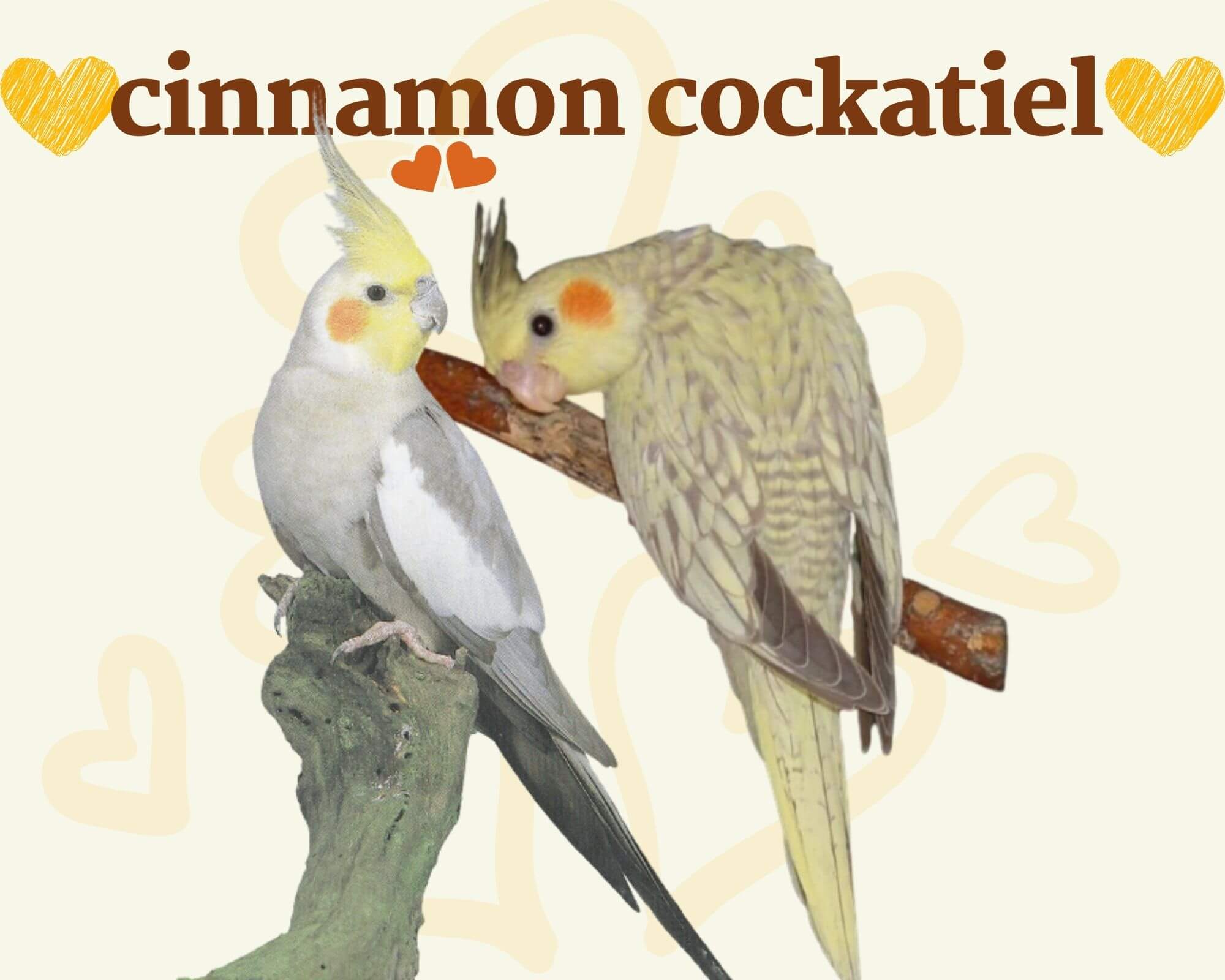
The bird is brown instead of dark gray.
Lutino Cockatiel
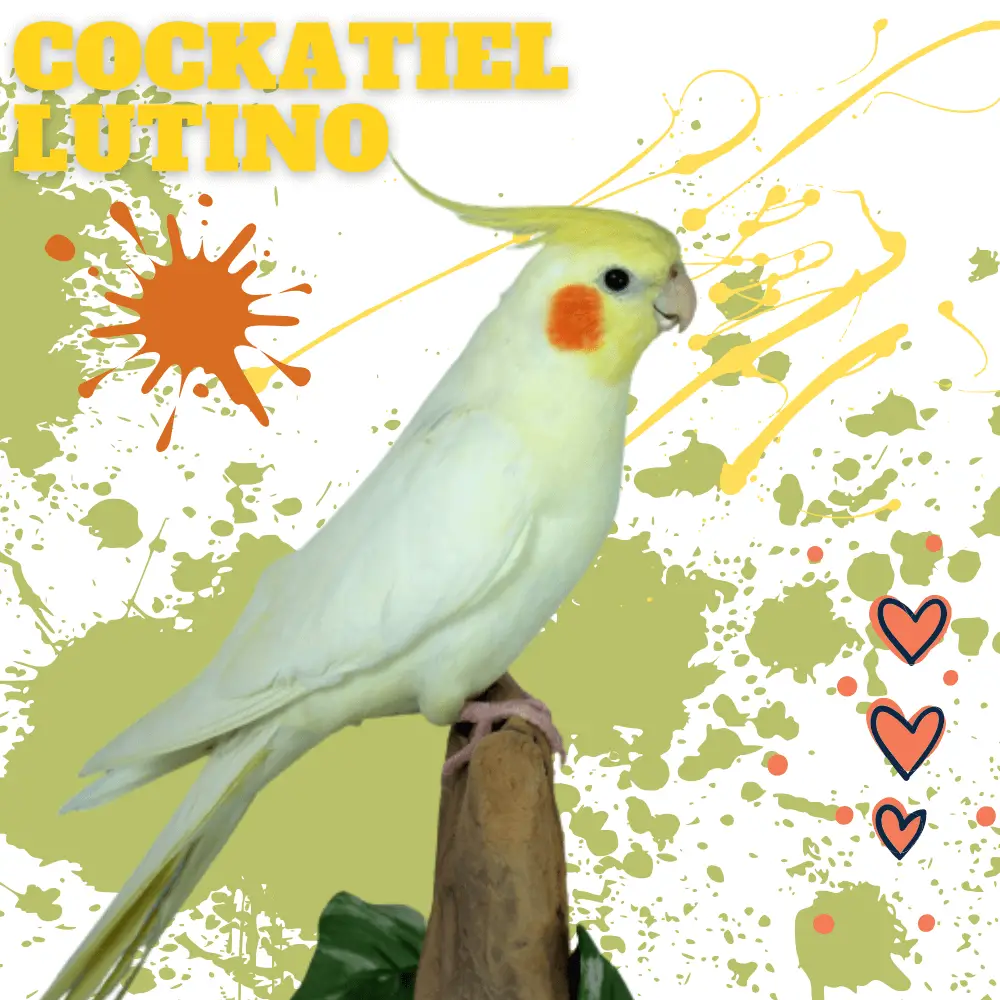
Cockatiel Mutation
The genotype called lutino causes mutations that suppress certain melanins. The ino groups 3 phenotypes according to the mutations with which it agrees (example: mutation ino + mutation face white will give an albino bird):
– the “wild” ino face: the lutino
– the pale ino face: the cremino
– the white ino face: the albino
Pearl Cockatiel
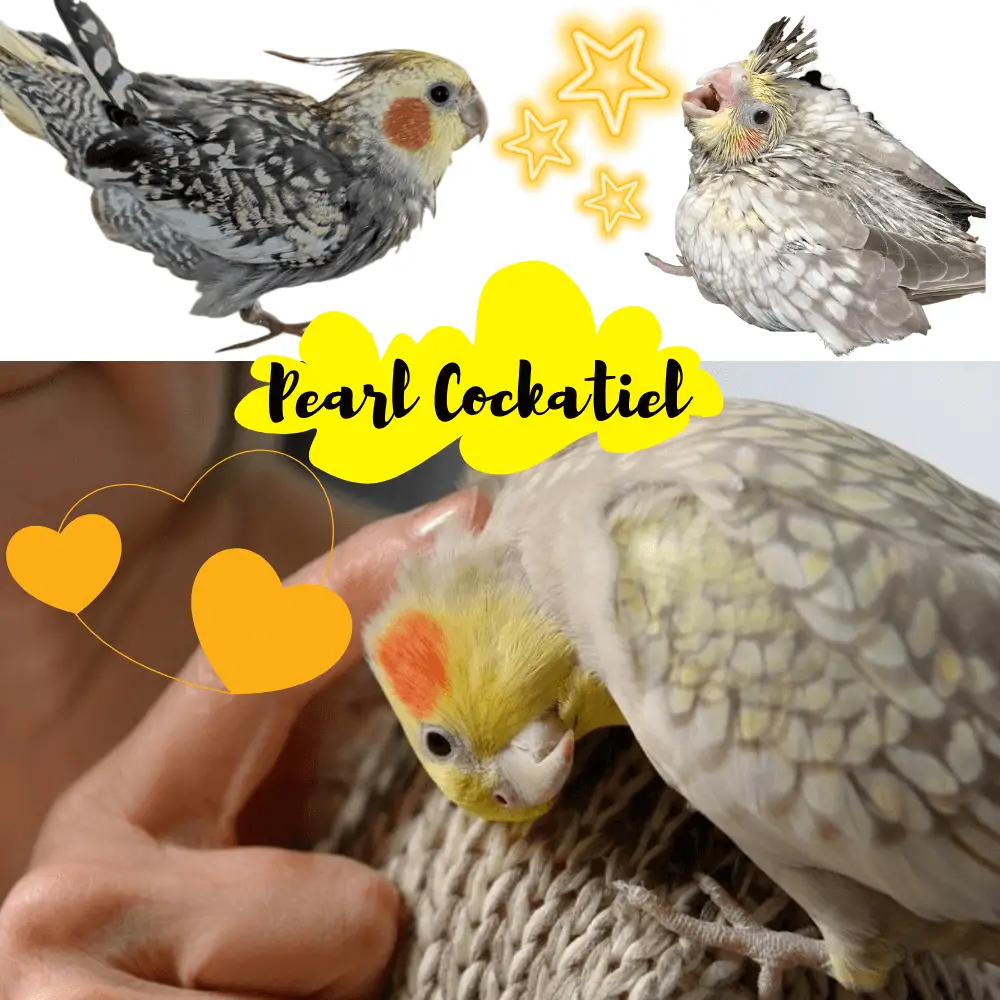
Cockatiel Mutation
females and young cockatiels have drawings of pearls on feathers, this mutation does not affect males
Yellow cheeks
The bird has yellow cheeks instead of red, due to the absence of red pigmentation.
The White Face cockatiel
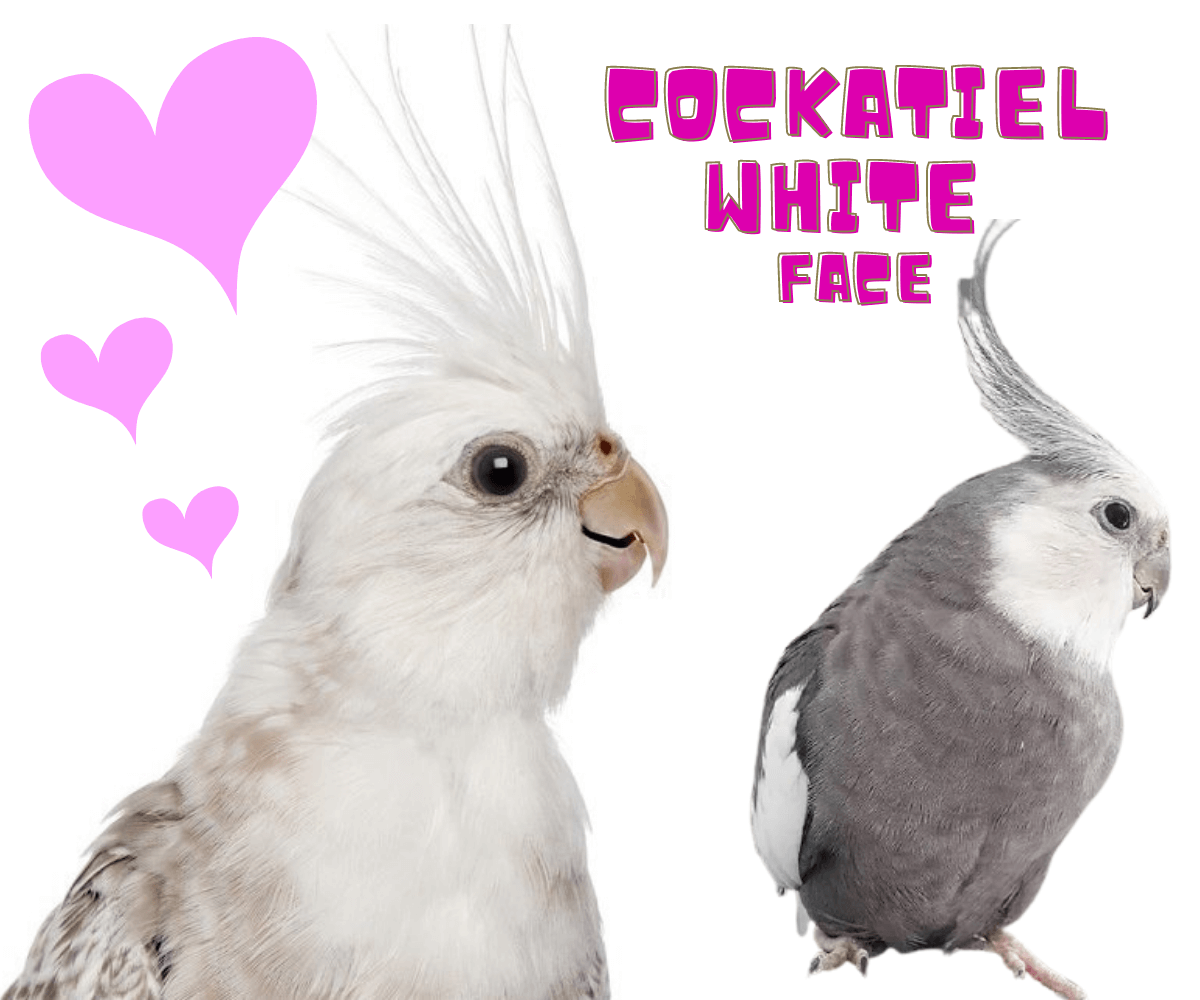
Cockatiel Mutation
The bird is gray and white in the absence of yellow and red pigments. The presence of a white line around a yellow mask in wild-type cockatiels is a sign that it carries the White Face mutation.
The variegated (PAN):
The bird randomly has white spots on its body. If the cockatiel is variegated only on the wings, it is said to be “ensouled”.
What is the rarest cockatiel mutation?
The whiteface cockatiel parrot is the rarest mutation of the cockatiel parrot species
What is the best cockatiel mutation?
lutino cockatiel Mutation It is among the most popular cockatiel mutations. This mutation which is sex-linked recessive (transmitted by the male to his daughters)
Top 14 Cockatiel colors and mutations
SOURCE:finch forum
Related Articles
- Hand feeding cockatiel
- How to set up a cockatiel cage
- Cockatiel diarrhea
- Cockatoo vs cockatiel
- Difference between cockatoo and cockatiel
- Adopting a cockatiel all you need to know
- Cockatiel origin and physiology
- Cockatiel emergencies
- Cockatiel lesions injuries and masses
- Cockatiel treatment and preventive care
- Cockatiel pecking
- Cockatiel behavior
- Cockatiel anatomy
- Cockatiel bites




















